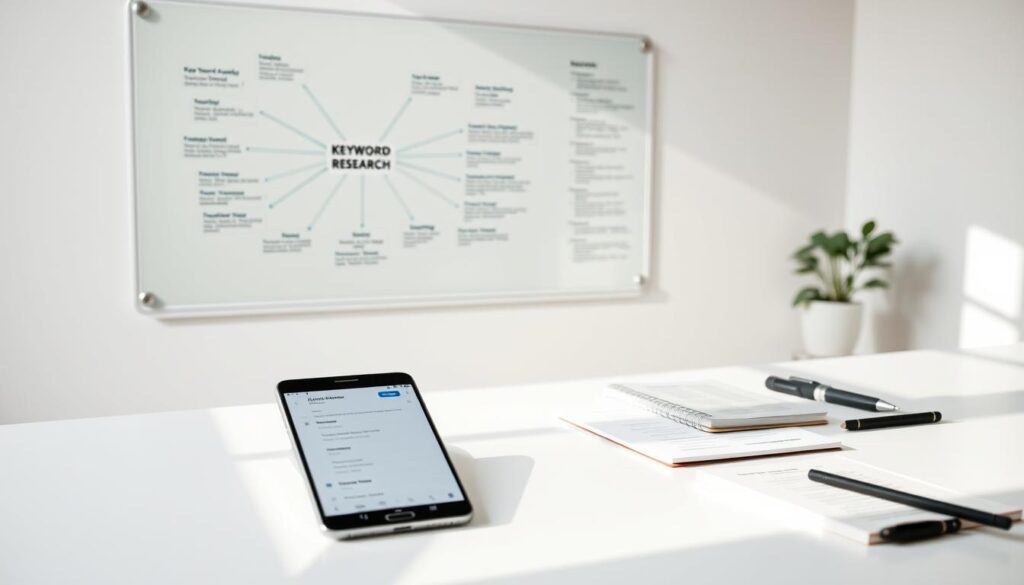Imagine your website as a hidden gem in a vast digital landscape. Without the right tools, potential customers might never find it. That’s where search engine optimization steps in. By aligning your content with what search engines prioritize, you can climb the ranks of search results and attract more organic traffic.
Effective strategies focus on three pillars: on-page, off-page, and technical SEO. On-page tactics refine content and keywords. Off-page efforts build credibility through backlinks. Technical adjustments ensure your site loads quickly and works smoothly across devices. Together, they create a seamless experience for both users and search engines.
Quality content remains the backbone of success. When paired with smart optimization, it drives sustainable growth. This article breaks down actionable steps to improve visibility, engage audiences, and stay ahead in competitive search results.
Key Takeaways
- SEO enhances online visibility by aligning with search engine algorithms.
- Combining on-page, off-page, and technical strategies maximizes impact.
- Clear, optimized content helps users and crawlers understand your site.
- Organic traffic from search engines builds long-term success.
- Technical improvements ensure fast, mobile-friendly site performance.
Understanding SEO and Its Importance in Digital Marketing
The internet is a crowded marketplace, and without the right approach, your voice gets lost. Search engine optimization acts like a megaphone, amplifying your website’s visibility. It’s not just about keywords—modern strategies blend technical precision with content that answers real questions.
Defining SEO in the Modern Digital Landscape
Think of engine optimization as a translator between your site and search algorithms. By refining title tags, meta descriptions, and page speed, you help crawlers understand your content. For example, a bakery site using “gluten-free cupcakes near me” in titles ranks higher for local searches.
Why Search Engines Matter for Your Business
Platforms like Google prioritize user experience. Slow-loading pages or confusing layouts drop rankings. Sites offering clear answers to “how to fix a leaky faucet” often appear first because they match intent. This alignment builds trust with both visitors and algorithms.
Every tweak—from mobile-friendly designs to structured data—makes your website easier to index. Brands that adapt to these engine optimization standards see steady traffic growth. After all, 75% of users never scroll past the first page of search results.
how seo helps in digital marketing: Key Benefits and Insights
Visibility in search rankings acts like a beacon, guiding potential customers to your online presence. When your content aligns with what audiences seek, organic traffic flows naturally. This approach avoids the fleeting results of paid ads, creating sustainable pathways for discovery.

Building Trust Through Consistent Engagement
High-quality articles and guides position your site as an authority. Users who find answers to their questions return, fostering loyalty. For instance, a plumbing company publishing “10 signs your water heater needs repair” attracts homeowners actively seeking solutions.
Improved rankings also boost credibility. A business appearing on page one of search results is perceived as trustworthy. Over time, this builds customer relationships that outlast seasonal marketing campaigns.
| KPI | Impact | Measurement |
|---|---|---|
| Organic Traffic | Indicates content relevance | Google Analytics sessions |
| Bounce Rate | Reflects user engagement | Percentage of single-page visits |
| Conversion Rate | Shows audience intent | Form submissions or purchases |
Tracking these metrics reveals what works. Pages with low bounce rates and high time-on-page signal valuable content. Adjustments based on data keep strategies aligned with evolving search behaviors.
Exploring On-Page SEO Strategies
Your website’s content is like a storefront window—clear, inviting, and easy to navigate. On-page strategies ensure search engines and users instantly grasp your message. Let’s dive into practical ways to refine your pages for better visibility and engagement.
Optimizing Content, Title Tags, and Meta Descriptions
Start with title tags—they’re your first impression. Keep them under 60 characters and include primary keywords. For example, “Best Organic Coffee Beans | Fresh Roasts Delivered Weekly” clearly states the page’s purpose. Meta descriptions should tease value in 150 characters, like a movie trailer for your content.
URLs need simplicity. Instead of “/blog?id=123,” use “/how-to-brew-french-press.” This clarity helps engines categorize pages and users remember links. Internal linking also matters—guide visitors to related articles or products naturally.
Improving User Experience through Structured Layouts
Clean designs keep visitors engaged. Use headers (H2, H3) to break up text, bullet points for quick tips, and white space to avoid clutter. A cooking blog might organize recipes with ingredient lists, step-by-step instructions, and nutritional facts—all easy to scan.
Page speed is non-negotiable. Compress images and minimize code to shave loading times. One outdoor gear brand saw a 40% drop in bounce rates after optimizing their product pages. Structured layouts don’t just please users—they signal quality to algorithms.
Mastering Off-Page SEO Techniques
Think of your website as a puzzle—off-page strategies connect it to the wider web. While on-page efforts polish your content, external signals determine how engines and users perceive your authority. This section explores proven methods to build credibility beyond your domain.

Building High-Quality Backlinks
Backlinks act like votes of confidence from other sites. A local bakery earning mentions from food bloggers or regional guides gains trust with engines. Focus on relevance—links from industry-related sources matter most.
Effective tactics include:
- Guest posts on reputable blogs (e.g., contributing kitchen tips to a cooking site)
- Collaborating with partners for resource roundups
- Creating shareable infographics that journalists cite
| Strategy | Benefit | Risk Level |
|---|---|---|
| Guest Blogging | Targeted traffic + authority boost | Low |
| Paid Link Networks | Quick rankings | High (penalties) |
| Broken Link Building | Natural placements | Moderate |
Utilizing Social Media and Influencer Marketing
Shares on platforms like Instagram or LinkedIn extend content reach. A tech startup partnering with YouTube creators for product demos can drive referrals. These signals don’t directly affect rankings but boost brand visibility.
Always prioritize organic growth. One outdoor brand grew organic traffic by 200% in 6 months through micro-influencer partnerships. They focused on authentic storytelling rather than forced promotions.
Remember: Sustainable off-page SEO requires patience. Quick fixes often lead to penalties. Build relationships, not just links.
Enhancing Visibility with Technical SEO
Technical optimization acts as the foundation of your online presence. Without it, even the best content struggles to reach its audience. Think of it as tuning a car engine—hidden work that ensures smooth performance and reliability.
Speed and Crawlability: The Silent Performers
Slow websites frustrate users and search crawlers alike. Compress images, enable browser caching, and leverage content delivery networks (CDNs). A travel blog reduced load times by 50% using these steps, doubling page views.
Mobile responsiveness is non-negotiable. Over 60% of searches happen on phones. Test your web pages across devices. Tools like Google’s Mobile-Friendly Test highlight layout issues instantly.
Structured Data and Sitemaps: Translating Context
Schema markup helps engines decode your content. A recipe site using schema might display ratings and cook times directly in search results. XML sitemaps act as roadmaps, guiding crawlers to every important page.
Regular audits catch broken links or duplicate content. One e-commerce store fixed 200+ crawl errors, boosting organic traffic by 35% in three months.
| Focus Area | Action Steps | Tools |
|---|---|---|
| Speed Optimization | Compress images, minify CSS/JS | PageSpeed Insights |
| Mobile Check | Test responsive design | Google Mobile Test |
| HTTPS Security | Install SSL certificate | Let’s Encrypt |
| Sitemap Submission | Update XML file monthly | Google Search Console |
These steps create a seamless experience for both visitors and algorithms. Technical health isn’t glamorous—but it’s what keeps your web presence running smoothly.
Leveraging Local SEO for Regional Growth
For businesses serving specific areas, local visibility can make or break success. Local SEO connects brick-and-mortar stores with nearby customers searching for immediate solutions. It’s the difference between appearing in “coffee shops near me” results or getting buried on page five.
Optimizing Google Business Profile and Local Citations
Start by claiming and updating your Google Business Profile. Add quality photos, accurate hours, and services offered. A bakery listing “gluten-free options” and “curbside pickup” attracts targeted traffic.
Consistency matters across local directories like Yelp and Yellow Pages. Ensure your business name, address, and phone number match perfectly on all websites. Discrepancies confuse search algorithms and customers alike.
| Strategy | Action Steps | Impact |
|---|---|---|
| Profile Optimization | Add keywords to service descriptions | Higher local rankings |
| Citation Management | Audit 50+ directories monthly | Improved trust signals |
| Review Management | Respond to feedback within 24 hours | +42% click-through rates |
Monitor performance using tools like BrightLocal. Track how often your business appears in “map pack” results—the top three local listings get 44% of clicks. Real-time updates let you adjust strategies quickly.
Local SEO isn’t just about being found—it’s about being chosen. A hardware store optimizing for “emergency plumbing supplies” became the go-to spot during weekend crises. Their visibility led to a 30% sales boost in six months.
The Role of Keyword Research in SEO
Keywords are the compass guiding users to your content. They reveal what people search for, why they search, and how your digital marketing strategy can meet those needs. By analyzing these terms, businesses align their messaging with real-world queries, bridging the gap between curiosity and solutions.

Identifying Trends and User Search Behavior
Effective keyword research starts with understanding intent. Are users looking to buy, learn, or compare? Tools like Google Keyword Planner and SEMrush uncover phrases like “best running shoes for flat feet” or “how to start a vegetable garden.” These insights shape content that answers specific questions.
Trends also play a role. Seasonal spikes in searches for “holiday gift ideas” or “tax filing tips” help brands stay relevant. Tracking these patterns ensures your industry content remains timely. For example, a fitness site targeting “home workout equipment” saw traffic triple during lockdowns by capitalizing on rising searches.
Competitive analysis sharpens your edge. If rivals rank for “organic dog food recipes,” creating a more detailed guide with video tutorials can outperform them. Tools like Ahrefs highlight gaps in their strategies, allowing you to claim untapped opportunities.
| Tool | Use Case | Data Provided |
|---|---|---|
| AnswerThePublic | Finding question-based queries | Visualized search questions |
| Ubersuggest | Competitor keyword gaps | Volume, difficulty scores |
| Google Trends | Seasonal demand tracking | Interest over time |
Accurate research transforms search engine results. A skincare brand targeting “cruelty-free moisturizer” instead of generic terms attracted ethically-conscious shoppers, boosting conversions by 22%. Keywords don’t just drive traffic—they connect you with the right internet users.
Elevating Content Optimization for Better Engagement
Great content is a journey, not a destination. It evolves as audiences grow and trends shift. To stay ahead, your marketing strategy must prioritize clarity and relevance. This means crafting pieces that answer questions before users even ask them.
Creating Compelling and Unique Content
Original research sets you apart. A fitness brand sharing “2024 Home Workout Trends” based on survey data gained 12,000 shares. Stories resonate too—case studies showing real results build emotional connections.
Use multimedia strategically. Videos demonstrating product features or infographics breaking down complex topics keep visitors engaged longer. One SaaS company increased time-on-page by 70% by adding tutorial clips to blog posts.
On-Page Optimization Techniques for Content Clarity
Headers act like signposts. Break articles into sections like “5-Step Editing Checklist” or “Common Mistakes to Avoid.” Bullet points simplify dense information, while bold text highlights key takeaways.
“Optimized content isn’t just readable—it’s actionable. Every sentence should guide users toward a next step.”
| Optimization Area | Action Steps | Impact |
|---|---|---|
| Headings | Use H2/H3 tags for subtopics | +50% scroll depth |
| Multimedia | Embed videos in tutorials | +40% engagement |
| Content Updates | Refresh stats quarterly | Maintains SEO rankings |
Audit older posts annually. A travel blog repurposed 2019 guides into “Post-Pandemic Packing Lists,” tripling organic traffic. Align updates with current web pages performance data to maximize impact.
Driving Credibility Through Effective Link Building
Building trust online requires more than great content—it demands strategic partnerships. High-quality backlinks act like digital endorsements, signaling to engine results that your site offers value. These connections elevate your authority while driving targeted traffic.
Strategies for Guest Blogging and Outreach
Guest posts on reputable sites create win-win opportunities. For example, a nutritionist writing for a fitness blog gains exposure while providing fresh content for the host. Focus on platforms aligned with your niche—this ensures relevance and audience overlap.
Balance on-page SEO with outreach efforts. Optimized anchor text and internal links work hand-in-hand with external referrals. A tech startup increased organic traffic by 65% after pairing keyword-rich articles with guest posts on industry forums.
Social media amplifies link-worthy content. Share articles across platforms to attract attention from potential collaborators. A B2B company used LinkedIn to promote a data-driven report, earning backlinks from 12 industry websites.
| Outreach Step | Tool | Outcome |
|---|---|---|
| Identify Targets | Ahrefs | Find sites with high domain authority |
| Personalize Pitches | Hunter.io | +300% response rate |
| Track Progress | Google Sheets | Monitor link placements |
Long-term credibility grows through consistent effort. Brands building diverse backlink profiles see sustained improvements in engine results. One e-commerce store maintained top rankings for 18 months by earning links from both blogs and news outlets.
Integrating SEO Within Your Digital Marketing Strategy
Think of your digital strategy as a team sport—SEO, social media, and paid ads each play distinct roles but share a common goal. When synchronized, they amplify brand visibility and drive measurable outcomes. This integration turns isolated efforts into a cohesive growth engine.
Combining SEO with Social Media and PPC
Social platforms extend the reach of optimized content. Sharing blog posts on LinkedIn or Instagram stories can spark engagement, sending signals that boost pages in search rankings. For instance, a fashion retailer saw a 25% traffic increase after promoting SEO-driven guides through Pinterest pins.
PPC campaigns complement organic efforts. Bid on keywords identified through SEO research to dominate paid and unpaid results. A travel agency targeting “family vacation deals” used Google Ads data to refine their organic content strategy, doubling bookings in six months.
| Channel | Role | Synergy |
|---|---|---|
| SEO | Long-term traffic | Guides content themes |
| Social Media | Audience interaction | Amplifies shares/backlinks |
| PPC | Immediate visibility | Tests high-value keywords |
Measuring ROI and Adjusting Tactics for Long-Term Success
Track metrics like organic click-through rates and conversion paths in Google Analytics. Tools like SEMrush highlight which strategy elements drive the most revenue. Monthly audits reveal gaps—like underperforming landing pages needing optimization.
Stay agile. When a home decor brand noticed rising searches for “sustainable furniture,” they updated product descriptions and launched targeted social ads. This pivot increased organic traffic by 40% and reduced paid acquisition costs by 18%.
“Integration isn’t optional—it’s how modern brands stay competitive. Data tells you where to double down.”
Conclusion
Your online journey thrives when strategy meets adaptability. Combining on-page precision, backlink credibility, and technical agility creates a ripple effect. Businesses that master this blend see lasting visibility in crowded markets.
Consistent improvements—like refining content or monitoring rankings—keep your audience engaged. Real growth happens when you test new approaches and adjust based on data. Think of it as tuning an instrument: small tweaks create harmony between user needs and search algorithms.
People trust brands that appear consistently across platforms. Local optimization builds community connections, while mobile-friendly designs cater to modern browsing habits. Every technical fix and quality backlink strengthens your digital foundation.
Ready to transform your approach? Start by auditing current strategies, then prioritize one area for enhancement. Whether boosting page speed or crafting shareable guides, progress compounds over time. Sustainable success begins with action.
Explore tailored solutions today—your audience is waiting to discover what you offer.
